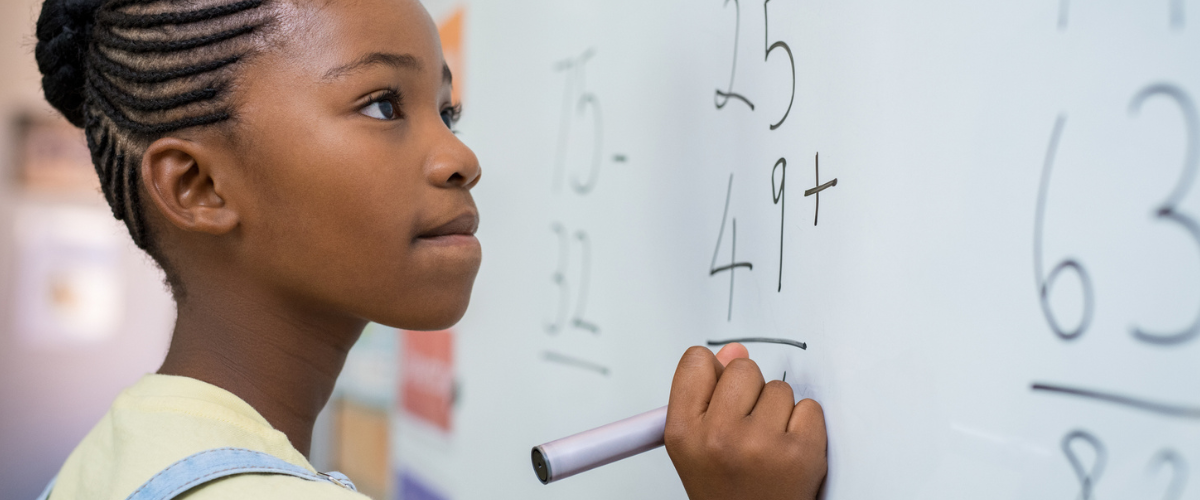Reasoning is a fundamental math skill that’s vital for helping your kids develop into confident and resourceful mathematicians. So opportunities for your kids to develop reasoning skills should be a core part of your math homeschooling.
Alongside conceptual understanding and problem-solving, mathematical reasoning forms the foundations of kids' math skills and knowledge, as it allows kids to use their math knowledge to make connections between areas of math and solve problems and make sense of math for themselves.
We've put together a helpful guide that explores why reasoning is essential when homeschooling math, but how do you actually include reasoning within your math homeschooling?
Adding reasoning into homeschooling doesn’t have to be hard work
The great news is that it doesn't have to be lots of extra work to get your kids' reasoning. You can use some simple question structures to help get reasoning into all of your math homeschooling sessions.
We've unpicked four key questions constructs you can use to get your kids' reasoning below. We've looked at why they are effective and given at least two examples from different grades of how you could use them in your math homeschooling.
For each construct, you'll also find some top tips and things to watch out for, as well as which of your kids' reasoning superpowers they will help develop. So, let's get started!
Always, sometimes, never
Give your child a statement and then ask whether it is always, sometimes, or never true.
Why it’s effective
This line of questioning encourages children to think about mathematical proof and allows them to develop the key skill of proving or disproving a statement. This key question structure is effective in encouraging children to make connections between different areas of math and for encouraging generalizations and algebraic thinking.
This question structure helps kids use their conjecturing, convincing, specializing, and generalizing math superpowers.
Examples
1st Grade
First, ask: Is it always, sometimes, or never true that a hexagon has equal-length sides?
Then say:
- What makes a hexagon a hexagon?
- Can you draw a hexagon that doesn’t have equal sides?
- What do we call hexagons with equal sides?
Example Answer: Sometimes true. A hexagon is any shape with 6 straight sides, but the sides do not have to be the same length. A hexagon with sides that are all the same length is called a regular hexagon.
4th Grade
First, ask: Is it always, sometimes, or never true that a prime number greater than 5 can't end in the digit 5?
Then say:
- Let's write down some prime numbers. Do any of them end in 5?
- Why do you think this is always/sometimes
ever true?
Example Answer: It is always true. All numbers above 5 that end in 5 are multiples of 5 and, therefore, cannot be prime numbers as they would have more than 2 factors.
Top tips
- This strategy can work particularly well if your child can discuss their thoughts and reasoning with others.
- You can play 'devil's advocate,' giving children different examples to check against their initial answer. For example, if you asked your fourth grader, “Is it always, sometimes, or never true that multiplying a number makes it bigger?” You could encourage your child to think about all possibilities by asking, “What about if you multiplied by a decimal?”
- You could also give your kids sets of statements to sort into 'always true,' 'sometimes true,' or 'never true.’ These statements could be from one area of mathematics (e.g., fractions) or a mixture of areas. You can then extend this activity by asking how they could change the statements to make them always true, sometimes true, or never true.
- Older children (from 3rd Grade and up) should be encouraged to move towards generalized statements, and 6th graders and above should also be encouraged to think of an algebraic representation of their answer, especially when the statement is 'always true'.
Watch out for…
Keep an eye out for children asking what you need to define something as always true; this can be used as an effective discussion point about the nature of mathematical proof.
Try asking: How many examples do you need to give to prove a statement is not true? What do you need to do to prove a statement is always true?
Another, another, another
Give your kid a statement and ask them to give you examples that meet it, and then ask for another example, and another, and another…
Why it’s effective
By asking them to repeatedly give another example that meets the statement, children develop their skills of specializing. This strategy also provides a good opportunity to assess children’s conceptual understanding of an area of mathematics.
This question structure helps kids use their specializing, generalizing, and imagining math superpowers.
Examples
Kindergarten
First, ask: Can you give me an example of two numbers that add up to 10? Another, another, another…
Then say:
- What if one number had to be above 5?
- What if both numbers had to be the same?
- How do you know you have found all the possible answers?
Example answer: Any pairs of numbers that total 10. Kids in kindergarten should be able to find all pairs of numbers that total 10, and you could represent these using part-part-whole models.
Is your child struggling with number bonds and math facts?
Then why not sign them up for one of Outschool's 1:1 math tutoring, or math classes, and math camps where they can have fun learning alongside others their age?
3rd Grade
First, ask: Can you give me an example of a multiple of 4? Another, another, another…
Then say:
- What does ‘a multiple’ mean?
- What do your responses have in common?
- What if your answer had to be a 3-digit number?
- What if your answer had to be a 4-digit number? What about if it was a 4-digit number that didn't end in 0?
Example answer: Any numbers that divide exactly by 4, for example, 16, 32, 80. Your child could generate 3 and 4-digit numbers by multiplying a multiple of 4 by 10, 100, or 1,000 — for example, 160 and 3,200.
They may also give answers that don’t end in 0, and you can easily check these as any number where the last 2 digits are a multiple of 4 is also a multiple of 4, so for example, 1016, 6532, and 70,456 are all multiples of 4.
7th Grade
First, ask: Can you give me an example of two numbers whose sum is less than 1? Another, another, another…
Then say:
- What if you couldn’t include a decimal?
- What if only one number could be negative?
Example answer: Any numbers that, when added together, make less than 1. Your child may first think about adding decimal numbers. For example, 0.23 + 0.34 = 0.57. However, negative numbers can also total less than 1. For example, -8 + -3 = -11 or 5 + -9 = -4.
Top tips
- Initially, ask your child for one example that meets the criteria set, and then, after a pause, ask for another. Continuing doing this, pausing slightly each time to allow them time to think about and construct their response until they have exhausted the possible responses and/or a generalization has been made.
- You can focus the use of this strategy by introducing caveats (e.g., give me another that involves a negative number).
- You can encourage your kids to generalize by focusing on what their responses have in common.
- The activity can be extended further by asking your kids how many possible answers there are or asking them to convince you that their response is true. This is especially interesting if there are infinite possible responses, as the reason for this can be explored.
Watch out for…
Sometimes children will become 'fixed' on a specific rule or generalization to generate each response. In these instances, simply modifying the statement by introducing a caveat, as described above, is an effective way to focus children's thinking.
What's the same? What's Different?
Give your kid at least two statements, objects, or numbers and ask them to compare them by asking: 'What's the same? What's different?'
Why it’s effective
This strategy encourages and fosters your child's ability to spot patterns and similarities, generalize and spot connections between various aspects of mathematics. The open-ended nature of this question structure means kids can contribute regardless of their confidence, knowledge, or experience in an area of math.
This question structure helps kids use their conjecturing, convincing, generalizing, organizing, and classifying math superpowers.
Examples
2nd Grade
First, ask: What’s the same, and what’s the difference between addition and multiplication?
Then say:
- If you switched the order of numbers in a multiplication or division, would the answer change?
- How is multiplication linked to addition?
Example answer:
Same: Both multiplication and addition are commutative, which means the order of the numbers doesn't impact the result of the calculation (e.g., 4 x 6 = 6 x 4 and 9 + 13 = 13 + ,. Multiplication is repeated addition (e.g. 4 x 3 = 3 + 3 + 3 + 3.)
Different: Multiplication is lots of the same number, whereas addition is normally adding two or more different numbers together. Multiplying by 0 always results in 0, whereas adding 0 to a number gives you the same number you started with.
5th Grade
First, ask: What’s the same and what’s different about 7000, 70, and 0.7?
Then say:
- What happens when you multiply or divide a number by 10?
- What do you have to multiply by 0.7 to get 7?
- What would you need to multiply 7 by to get 70?
- So, what would the relationship be between 0.7 and 70?
Example answer:
Same: All related to 7 by a multiple of 10 (i.e., they have been multiplied/divided by 10 or 100). All contain the digit 7.
Different: 0.7 is 100 times smaller than 70, and 7000 is 100 times bigger than 70.
Top tips
- You can use the strategy with two things, but it can also be effective with more than two, as this can help develop children's ability to spot relationships.
- You can extend this strategy by asking kids to identify the ‘odd one out’ of a list of 3 or more items.
Watch out for…
Children may point out 'superficial' similarities/differences (e.g., they are both numbers). However, the more often children are exposed to this strategy, the more 'mathematical' their responses will become.
Children may also get 'stuck' after they have given a few 'obvious' similarities and differences. To help address this, try to encourage your kids to talk about your prompt question with another child, as talking with others is a terrific way for kids to develop their reasoning skills.
If you want to give your kids even more opportunities to talk about math, then why not sign them up for one of Outschool's online math classes, math tutoring, or math camps where they can talk about math with other kids under the guidance of their expert Outschool teacher?
Peculiar, obvious, general
Ask your child to give a peculiar, obvious, and, from around 3rd grade, a general example of a statement or question. For younger children, you could ask for a 'strange and obvious' example instead.
Why it’s effective
This strategy encourages kids to think about the structure of mathematics and the definition of the statement(s) you give them. By focusing on what makes a peculiar, obvious, or general example, kids have to think carefully about the statement given, the criteria needed to meet the statement, and what examples they could give.
The encouragement to give a peculiar example encourages your kids to push the boundaries of their understanding, while the general example encourages them to begin to generalize and for older kids to develop their algebraic thinking.
This question structure helps kids use their organizing, classifying, imagining, expressing, specializing, and generalizing math superpowers.
Examples
1st Grade
First, ask: Give me a strange and obvious example of an even number.
Then say:
- What even numbers can you think of?
- How do we know numbers are even?
Example answer:
Strange: 108, as it’s a 3-digit number.
Obvious: 2, as it's the first even number.
4th Grade
First, ask: Give me a peculiar, obvious, and general example of a pair of numbers with a product of 280.
Then say:
- What does ‘a product’ mean?
- Could you use repeated halving or doubling to find a strange pair of numbers?
Example answer:
Peculiar: 17.5 x 16 = 280 as it involves a decimal (but you can prove it gives a product of 280 by halving 4 times - i.e., 280 ÷ 2 = 180, 180 ÷ 2 = 90, 90 ÷ 2 = 45, 45 ÷ 2 = 17.5, halving 4 times is equivalent to 2 x 2 x 2 x 2 = 16 so 17.5 x 16 = 280
Obvious: 280 x 1, as it's clear it has a product of 280.
General: Any numbers which multiply together to make 280.
6th Grade
First, ask: Give me a peculiar, obvious, and general example of a prime number.
Then say:
- What is special about a prime number?
- How many factors does a prime number have?
- Are all prime numbers odd?
Example answer:
- Peculiar: 2 - as it's the only even prime number.
- Obvious: 3 - as it's the first odd prime number.
- General: Any number that has exactly 2 factors.
Top tips
- Encourage your kids to the first state and then record an obvious example by asking: What is the first example you think of? Why is this the first example you think of?
- Then ask them to think of their peculiar example. Encourage your child to think about the definition and criteria of the statement given by asking what fits the definition but isn't obvious.
- Finally, kids from third grade and up should be encouraged to think about a general example. This will deepen their thinking about the statement given and their understanding.
- You could encourage your child to explain their choices verbally or in writing, encouraging them to think about the definition of the given statement and the general structure of mathematics.
- You could give your own examples of an answer that is peculiar, obvious, or general and ask your child to try and convince you that it is not peculiar, obvious or general.
Watch out for…
Your child may rush to give a really large or small number as their 'peculiar' example. If this happens, ask them, “Is an answer peculiar just because an example is large or small? What makes it peculiar?
Could we not say it is quite obvious as all we have done is multiplied/divided by a multiple of 10?” You can also modify the question to remove the temptation to go really large, for example, “Can you give me a peculiar example of an odd number that is below 50?”
Want to include even more reasoning in your math sessions?
In the next blog in our math reasoning series, we've unpicked four more key question structures that you can use to help get your kids' reasoning when you are homeschooling math.
But did you know that when kids talk about and discuss math with others their age, they often start reasoning without even realizing it? So why not sign your kids up to have fun with math alongside others their age in one of Outschool's engaging online math classes?
Outschool offers a wide range of classes, including whole curriculum classes and math classes. You’ll find everything from Kindergarten math classes to 8th Grade, advanced math, and even math camps.
Bottom line, if you want some math support or subject matter expertise, you’ll find the right resource for your child’s needs on Outschool.


.svg)
.svg)







